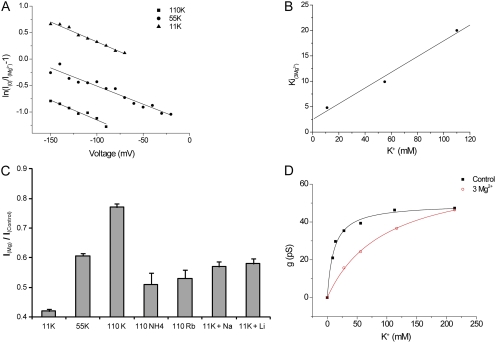Figure 7.
External K+ competes with Mg2+ block of Kir1.1 currents. (A) Analysis of block of K+ currents by 3 mM Mg2+ at three different external [K+] according to Eqs. 2 and 3. Lines represent KMg(0) = 4.6 mM and zδMg = 0.19 (11 mM K+); KMg(0) = 9.9 mM and zδMg = 0.18 (55 mM K+); and KMg(0) = 20 mM and zδMg = 0.19 (110 mM K+). (B) KMg(0) plotted versus [K+]. The straight line represents a linear regression fit of the data. The intercept on the ordinate implies that KMg = 2.5 mM in the absence of K+, and the slope provides an estimate of 15 mM for the dissociation constant for K+ displacement of Mg2+. (C) Ratios of currents at Vm = −100 mV in the presence and absence of 3 mM Mg2+ with different ions in the external solution. (D) External Mg2+ decreases the apparent affinity for K+. g is plotted as a function of [K+] for no added divalents (black) and with 3 mM Mg2+ in the external solution (red). Lines represent the best fits to Eq. 1, with gmax = 50 ± 1 pS and Km = 11.0 ± 1.3mM (control), and gmax = 67 pS ± 1 and Km = 96 ± 4 mM (+3 mM Mg2+).

